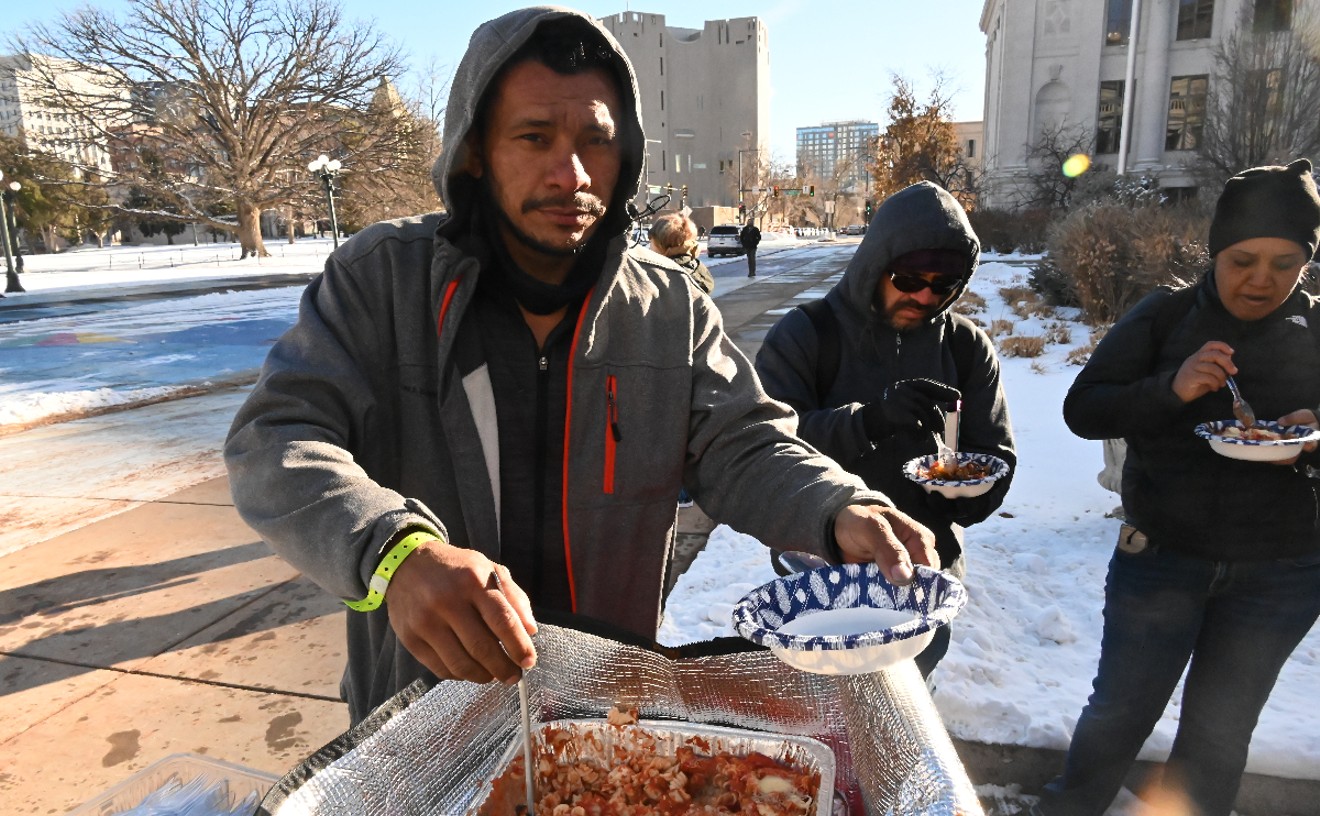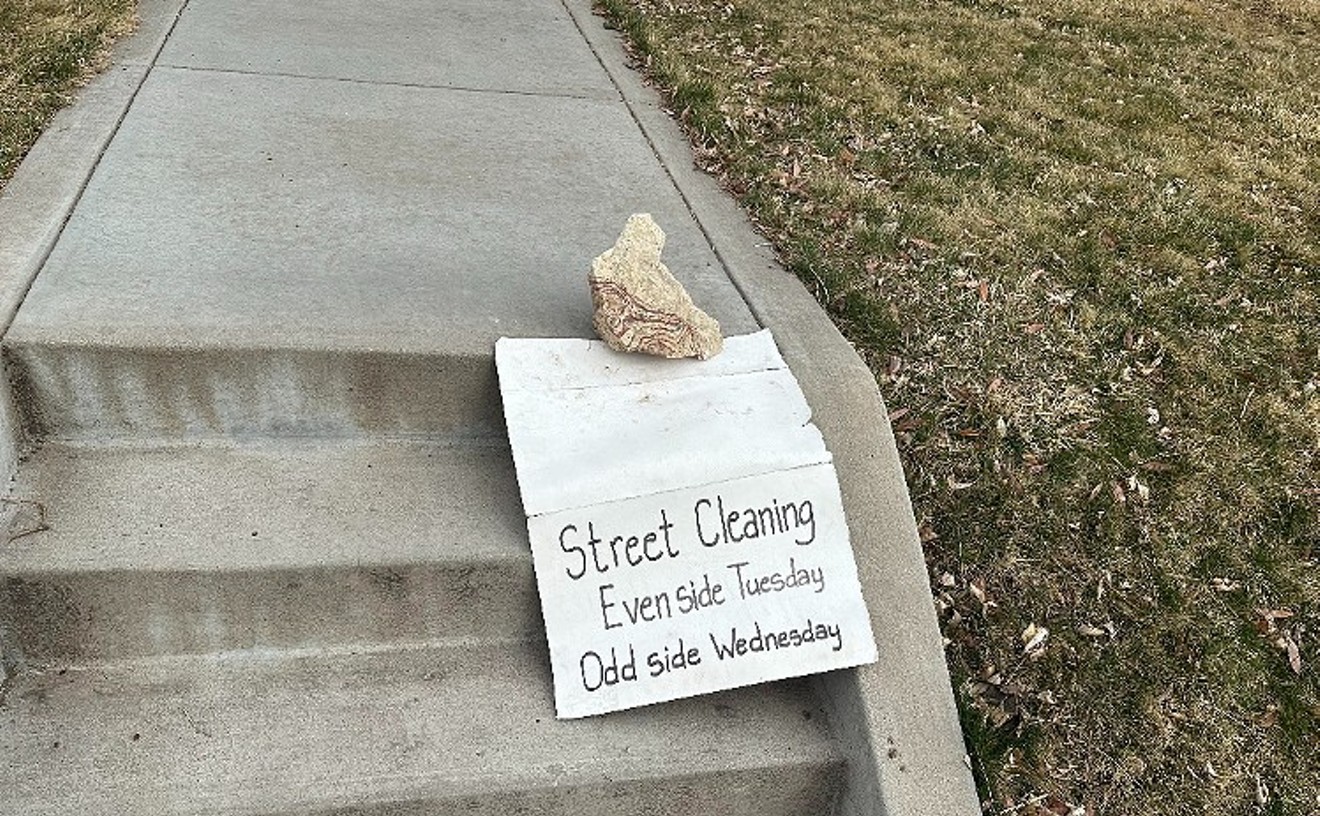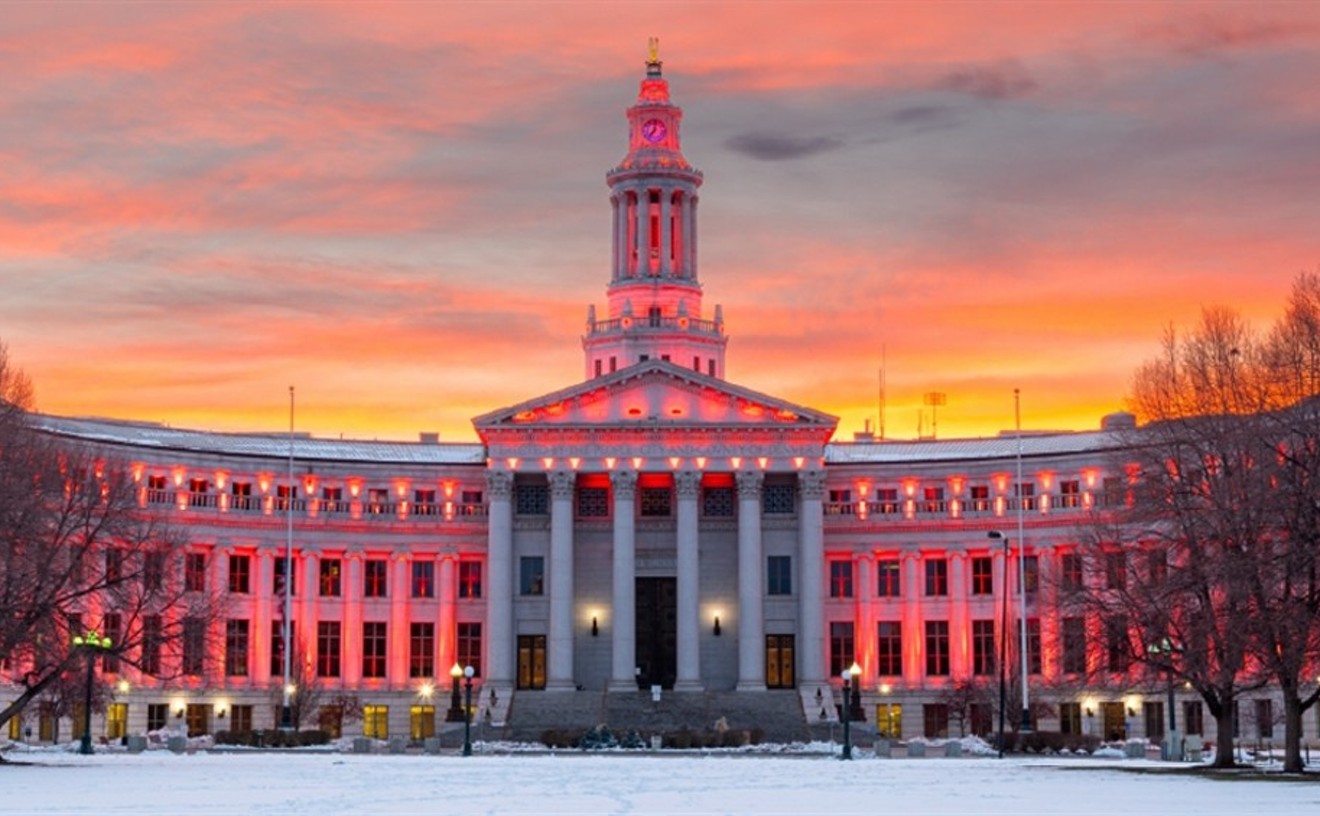Three minutes into the seven-minute ride on the Super Gauge Express chairlift at Winter Park, one of my guides turns, pulls down the turtleneck of his red ski jacket and says, "I think I'm not feeling safe enough. I think we should get safer."
Soon I'm following the two skiers and one boarder through a double-black section of glades covered with about a foot of loose powder wind-loaded into the trees overnight on top of crusty, week-old snow. In my wake are jagged boulders, fallen trees, spear-like branches and stumps. We stop for a second, and I learn that there are cliffs about 500 yards to the right. Usually the snow is good enough to ski them — but not this season. So we veer downhill, to avoid going over the ledge like Gore-Tex-wrapped lemmings.
After dropping another hundred yards down the pitch, we come to a more mellow part of the woods, where the tracks are a bit more packed down. Those tracks converge at a flat spot, where my guides have stopped in front of a clump of trees with what looks like a snow-covered stack of firewood at their base. By the time I've carved my way down to them, my guides have ducked into the entrance of Frog Hut, a hobbit-sized wooden shack camouflaged from view.
Secret shacks and huts like this exist in the woods not just at Winter Park, not just at ski resorts across Colorado, but across the United States and Canada. And they're all designed as places where skiers and boarders can duck in for a quick warm-up and sometimes to get safe — mountain slang for puffing a quick bowl. It may seem counterintuitive in a demanding, athletic sport, but getting stoned is an intrinsic part of the snow-day routines of many skiers and boarders. Some say it helps them focus on the singular task very literally in front of them; others enjoy the spiritual connection with nature often provided by a joint of good herb.
The anonymous trio I'm with has been meeting at this hidden hut for years, getting safe before heading back out into the knee-shattering moguls of a nearby double-diamond run. Though other skiers, snowboarders, mountain managers and ski-patrol members certainly know of the Frog Hut's existence, the spot is still officially a secret, and I've sworn to keep its location secret, as well. (I've also promised to keep the identities of my guides — respected members of the Denver business world — confidential.)
While the few resort spokespeople who acknowledge that they've heard of smoke shacks all insist that they don't exist at their mountains, many of these spots have stood for decades, relics of the past and beloved testaments to individualism in a sport growing increasingly corporate. Once a secret shared only by word of mouth, today a quick Internet search brings up scores of discussion forums on which riders detail their favorite on-mountain escapes and post pictures. Some are mere shanties with dirt floors and logs to sit on; others are extravagant structures outfitted with tables, benches made of snowboards and stairs constructed of skateboard decks leading to second-floor observation towers. Some have attained near-mythical status and earned such nicknames as The Igloo, Leo's, Bob's Office, The 420 Club, Horsecock Cavern, The Cheetah Den, Topher's Trees, Frog Hut, The Foggy Goggle, Marley's and No Fat Chicks (so named because of its very small entrance).
Legend has it that some of the shacks on Mary Jane date back to before there was even a ski hill to schuss down. A few evolved from lean-tos left behind by miners; others were created by the logging crews called in to clear the trails before Mary Jane's opening season in the winter of 1975-1976. Instead of heading down the mountain at night, the workers would build huts where they could stay during the mild summer nights. One well-known hut that sat in a small grove near what became the free parking lot at Mary Jane was largely dismantled this past off-season, the log walls left behind to create a snow-covered modern ruin.
Other huts have been put up as memorials to lost friends. One of those is a smoke shack in Topher's Trees, named for 26-year-old snowboarder Christopher Sendroy, who died after falling into the quicksand-like snow of a tree well in 1995. There's a small shrine to Sendroy put up by family and friends on a tree near the site of the accident. But what has become the biggest monument to Sendroy is Topher's — a two-story wooden smoke shack bearing his name that reportedly was built around the evergreen where Sendroy died.
Also read: On Aspen Mountain, visiting memorial shrines is a tradition
Needless to say, protecting the shacks is a time-honored tradition. While a few are out in the open — like a bench above Springdipper at Keystone that's visible not only from the trail, but also from the chairlift and gondola, and which patrollers and lift operators are more than happy to point out — people who know about the shacks generally keep their existence quiet. As my Winter Park guides stress over and over, most of these places are well hidden and their actual locations known only by a small, unofficial club of skiers and riders skilled enough to reach the precariously located huts and smart enough to keep their locations secret so that a good thing can last.
You have to know someone to show you these places — and after that, you shouldn't show them to everyone else you know. It's like a stoner version of the first rule of Fight Club: You do not talk about the location of the smoke shacks.
*****
Considering that Breckenridge, the town, has legalized marijuana, it's not surprising to learn that Breckenridge mountain is home to nearly a dozen smoke shacks that are known the world over. High Country Caregiver, a frequent Westword commenter on all subjects marijuana-related, is also an expert on Breckenridge's many smoke shacks, huts and tepees. Caregiver — who asked that his real identity not be revealed — worked for the ski area for six years as a market-research manager.
Caregiver probably wouldn't have made it in Fight Club: On his website, he lists the GPS coordinates of seven of Breck's most historic huts, including the notorious Leo's Smoke Shack. That two-story shack has graced the pages of numerous ski magazines and has been the subject of enough ski forums that tourists occasionally ask to see it. But Caregiver doesn't apologize for spreading the word. "All I can say in my defense is people come to ski Breckenridge specifically to find the smoke shacks, and it's a great destination to ski and enjoy cannabis at the same time," he says, showing his skills at MMJ market research. "The reality of ski patrol, cops, Forest Service — whatever — tearing them down is completely independent of what I say and the maps I provide. If any of that were to happen, it would have happened or could happen totally regardless of anything that I ever said."
Caregiver says he averages about three smoke-shack stops each time he is on the hill, and claims to have visited the dozen or so Breckenridge shacks as many as 2,400 times over the fifteen years he's lived in the area. "Smoking marijuana is a very important part of skiing and a very strong part of the culture, especially for Breckenridge," he says. "It's great to have semi-secret underground smoke locations that are accessible off almost every lift. I've had awesome experiences hanging out with crew after crew of riders who pass by, blaze and keep riding. Young, old, male, female, all walks of life — the shack, man, the shack is so awesome."
According to Caregiver, Breckenridge officials generally turn a blind eye as long as the shacks don't become a nuisance or pose a danger to the people using them. He says he's seen ski patrollers glide past shacks while he's been inside blazing, watched instructors take ski schools past the shacks as a sort of on-mountain attraction, and has even spotted families having a wholesome, weed-free lunch in the shacks.
"Although I use the shacks to smoke marijuana, above all they are a beautiful piece of ski culture and art that represent something much larger than just smoking cannabis," he explains. "To just assume that they are a place to smoke pot is missing the larger picture. The people who think that way are the same ones who think a powder stash is their secret powder stash or something. Everything on the mountain is everyone's to enjoy."
But the Forest Service doesn't see it quite that way.
*****
Jim Stark, winter sports manager for the U.S Forest Service, can't point to a specific time when the federal agency became aware of the huts and shacks popping up on national forest land. They've always kind of been there, scattered around ski areas and back-country trails. As far as he can tell, what are now called smoke shacks likely started out as warming huts built by elk hunters or lean-tos used by miners. Over the years, as ski areas began leasing federal land and expanding their resorts, the shacks became part of their terrain...and their responsibility.
The older shacks tend to be ignored at most ski areas, Stark says. Some, like those at Winter Park, predate the ski area's existence and blend into the landscape. The few he hears about are the newer shacks Stark calls "summer jobs," whose construction involves cutting down living trees, stripping branches and using forest resources. These shacks have been growing in complexity over the last few decades, and some are now sprawling creations that rival (if not trump) the living quarters of the local ski bums who help build them.
The rare complaints that come into Stark's office are never about stoned riders and skiers visiting these shacks. Instead, they focus on environmental damage and concerns that hearing about the spots could lure inexperienced skiers into extreme terrain. But what Stark says he really gets gripes about are the growing number of on-mountain shrines. Scattered around the woods of Aspen and Snowmass are impromptu memorials devoted to famous and infamous dead celebrities ranging from Elvis to Hunter S. Thompson, covered with pictures, beads and other memorabilia. "They are an eyesore to people," he explains, noting that humble shrines for friends lost on the mountain tend to be left in peace.
The most serious hut-related incident Stark can recall was a few seasons back, at tiny, three-lift Sunlight Mountain outside of Glenwood Springs. A few local teens had spent their day skiing in and out of a shack, where they'd drink booze. One kid was "chugging vodka," he recalls, and passed out in the shack. His friends were unable to rouse the teen, and decided to leave him behind after the lifts stopped running. But one friend thought better of that plan and told the ski patrol, and the kid was found woozy, suffering from hypothermia and nearly frozen.
Stark is able to laugh about that story now, but he uses it to illustrate why official Forest Service policy prohibits shacks; his agency suggests that resort operators pull them down when they come across them.
His most recent bust was in 2007, in a particularly busy Snowmass spot that Aspen Skiing Company had complained about. A summer job by Stark's estimation, the shack was more like a palace, with snowboard benches and a speaker system that visitors could play their iPods over. Stark admits he was impressed with the overall construction, but the "attractive nuisance" was pulled down soon after. "It's not so much the kids using it, because they know where it's at, but more so that it was leading sucker tracks into one area with cliffs," he explains. "Smaller kids — kids not in the know — got into that place where they shouldn't be. I mean, they are skiing trails you'd have to be stoned to want to ski."
But while the hidden huts can be a nagging nuisance for resorts, avalanche control and watching for misbehaving skiers on the main slopes take precedence over rousing a few stoners from their caves or pulling pictures of Jerry Garcia from the trees. At a resort like Breckenridge, it's not uncommon to have as many as 20,000 skiers on the hill on a busy day, and dealing with skier injuries alone is enough to strain the ski patrol. That leaves the shacks largely in the hands of the Forest Service, which are already full supervising hundreds of thousands of acres."That doesn't mean that one day in the middle of the winter, we're going to have this full-out assault," Stark admits. "It's like we tell the resorts, if your crews are working next to them in the summer, deconstruct them." Not that he's going to go out of his way to see if they have. "When I'm at the ski areas, I'm there to ski," Stark says. "I'm not there to look for shrines or shacks."
Others are, though.
In the spring of 2005, the Breckenridge ski patrol said that too many new huts had been popping up and too much trash was accumulating in the old ones, and they vowed to destroy all the shacks they found. According to Caregiver, this move came after someone climbing around in the three-story Tree House Shack off Peak 9 fell and injured himself badly enough that he had to be taken out by the ski patrol. Having seen the shack and recognizing the danger inherent in having people stumbling up makeshift log ladders in ski boots, the ski patrol had no choice but to break it down. Still, the move angered some residents, who wrote to the local newspaper in defense of the huts, noting that they weren't always used to smoke weed; some people simply relied on them for shelter.
Other resorts have occasionally cracked down on huts over the past few years. In the spring of 2010, Gunnison District Ranger John Murphy waged war on the smoke shacks at Crested Butte and the puffers using them. The rangers wrote tickets for the people they found smoking herb, and fined two Western State College students $1,700 each for building a hut.
As online ski forums, blogs and ski movies keep spilling the locations of the smoke shacks and attracting more visitors to them, more mountains may start dismantling them. But there are still a few good secrets left — and new skiers and riders to carry on the Fight Club tradition.
*****
Just outside the ski-area boundary line in a relatively untraveled section of terrain is Breckenridge's newest smoke hut: The Hash Temple. The white canvas is almost invisible from every direction; I only spot it the first time because I happen to see a few skis stuck up in the snow nearby. Compared to the log structures built into the trees off nearby runs, the all-white Hash Temple is as easy to locate as a polar bear in a snowstorm.
A younger kid with a baby face, probably no older than twenty, is clicking into the pair of skis that had provided my first clue to the Hash Temple's whereabouts. He nods hello, then turns to thank the guys inside the canvas for the smoke before riding off. I can hear coughing and the shuffling of ski boots as I make my way into the tent, ask the two guys already inside if they mind my joining them, and take a seat. The shacks are generally welcoming places — they're on public lands, after all — and this one is no different.
A few bowl packs later, my hosts start exhaling the history of the Hash Temple. The pair, who've lived in the area for a few years, got sick of the other huts and shacks at Breck being abused by "gapers" — a derogatory mountain term for clueless tourists. So they spent the past summer lugging up the makings of an on-mountain stoner den, making twenty trips up and down the mountain in a four-wheeler. The Hash Temple is small — probably only large enough for six or seven people at most — but what it lacks in size and convenience, it more than makes up for in extravagance.
This shack is more like a safari-style canvas tent, complete with a heavy, wrought-iron stove for cooking, a mini iPod stereo for music, and a snowboard lounge chair and futon for relaxing. Several hippie tapestries with Eastern religious symbols and some prayer flags hang from the metal support poles at the top; a ragtag carpet covers the wooden platform on which the tent was constructed. But outside, the only thing that stands out from the white snow and green trees surrounding the shack is a small totem pole warding off evil spirits...and forest rangers on skis.
The hut was also a way to stake a claim to public land that's become increasingly expensive to enjoy, they explain. The price of season passes jumps every year, a day pass is more than $100, and even something as cheap as a candy bar at the base lodge costs as much as a gallon of gas. Pointing to the stove, one toker says they stock the tent with eggs and bacon to cook in the morning and other snacks to munch on through the day as they take turns on their favorite part of the mountain. "Fuck paying Vail Resorts for food, you know?" the twenty-something with the raccoon-like goggle tan says while melting snow over a portable camping stove.
What I assumed was soup turns out to be water that he uses to fill a tiny bubbler pipe he's pulled out of his backpack. His friend holds out a glass dish of Kush Haze hash oil that he passes around so we can all get a hit; a bowl of herb is sent in the opposite direction.
While ski resorts and the Forest Service officially frown on shacks like the Hash Temple, odds are that it will survive for a few years, then disappear on its own — when its patrons just stop putting it up each winter and move on. These tents tend to have a limited life, and even the wooden smoke huts will collapse without upkeep. But when one goes, another one will replace it.
"They'll pop up," the hash cook promises. "They'll always keep popping up."










